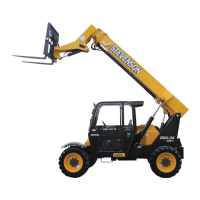PRINTED IN U.S.A. 59 913323/CP0112
NOTE: Perform all other service requirements
up to this point, as well as the following:
CHECKING HYDRAULIC SYSTEM
RELIEF PRESSURES
Pressure settings for relief valves are pre-set at the fac-
tory. Three test ports are provided under the front hood
access cover.
Before conducting any pressure checks, check the
engine speed. Engine speed must be 800 RPM at idle
and 2500 to 2550 RPM at high idle.
Steering Relief Pressure
Plug a 3000 psi (207 bar) oil- or liquid-filled gauge
into the test port labeled ”SP.” Turn the steering full to
the right or left. The gauge should read 2000 psi (138
bar).
Joystick and Parking Brake Release
Pressure
Plug a 1000 psi (70 bar) gauge into the port labeled
“JP.” With the engine running, the gauge should read
350 psi (24 bar).
Main Relief Pressure
Plug a 3000 psi (207 bar) oil-or liquid-filled gauge into
the test port labeled “MP.” Fully retract the boom over
the relief valve. The gauge should read 3000 psi (207
bar).
CHANGING HYDRAULIC RESERVOIR
OIL AND STRAINER
Clean all dirt and debris from around the top of the
reservoir, especially around the access cover. Refer to
illustration and use the following procedure:
1. Remove the drain plug and drain oil. Wash or blow
off any particles collected on the magnetic drain
plug.
IMPORTANT: DO NOT discharge oil onto ground.
Catch and dispose of per local waste disposal
regulations.
2. Remove the access cover and wash the inlet screen
with clean solvent. Remove and wash the sump fil-
ter strainer from the bottom inside of the reservoir.
If the strainer has any damage, holes, etc., it should
be replaced.
3. Flush out the bottom of the reservoir with clean
hydraulic oil. Re-install all cleaned components
and install the access cover on the reservoir with a
new gasket. Clean the filter/breather cap.
4. Fill the reservoir with fresh oil. Follow specifica-
tions in the Lubrication chapter of this manual.
IMPORTANT: Hydraulic fluid and filters should be
replaced any time contamination is present before
the normally scheduled change.
Service Every 2000 Hours or Two Years
Test ports under
access cover
Hydraulic Reservoir Sump Strainer Removal
Fill Cap
Dipstick
Access
Cover
Gasket
TOP OF
RESERVOIR
Element
WARNING
Escaping hydraulic oil under pressure can
have sufficient force to penetrate the skin.
Before applying pressure to the hydraulic sys-
tem, be sure all connections are tight and
lines and hoses are not damaged. Use a piece
of wood or cardboard to search for suspected
leaks. If injured by escaping hydraulic oil, see
a doctor familiar with this type of injury imme-
diately or gangrene may result.

